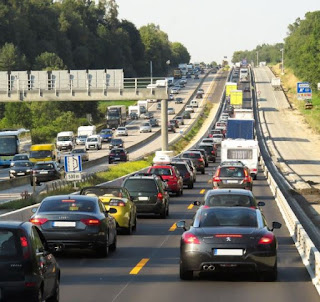Sharing the road
By Diane Tait
 |
| Image courtesy Pixabay |
So many cars.
So little time. – Everyone is in a
hurry these days. Whether it’s to get to work, to make it to Miami
before nightfall, or to head out to the mall to do a little Christmas shopping,
the roads are going to be packed with impatient drivers. While haste makes waste, that tenet is doubly
true this time of year. While winter
driving in Florida doesn’t include snow, that doesn’t mean that you’re not
going to be in for a bumpy ride from time to time. Everything from popup rain showers to
gridlock caused by rush hour traffic, tourists and shoppers are quite common in
December. Don’t let them spoil your
Christmas cheer. What this means is if
you want to get where your going with the least amount of stress, try to time
your trips to avoid the worst of the traffic.
Keep your distance and your cool. Have you ever noticed that the least patient
drivers are the most aggressive? While
the habits of Jacksonville drivers don’t seem to be quite as frantic as the
kamikaze pilots I seem to encounter every time I drive through Orlando, it isn’t
unusual for me to see an occasional driver using I-95 as a slalom run or have a
speedster barrel right up to my bumper, even if there’s no place for them to
go. While road hogs and street racers
can cause your blood pressure to spike, the best way to keep your cool is to
get out of their way. More importantly
is for all of us to avoid being a hazard to navigation ourselves. This means using sensible lane discipline,
giving other drivers room to breathe and using our turn signals.
All too many drivers act as though they own the road. This causes them to needlessly block traffic
by using the middle and left lanes in such a way that it forces faster traffic
to pass them on the right. It makes you
wonder if they ever took a driving course. Most drivers follow other vehicles way
too closely, regardless of the weather. Should
the driver ahead jump on the brakes, this is one sure way to wind up in a pile
up. Always give traffic ahead at least a
3-second lead in dry weather and a 5-second lead in wet weather. Do I really need to remind all of you not to
talk on the phone or text while driving?
And for Pete’s sake, learn how to use your turn signals. I can’t tell you how many times I’ve had cars
cut into my lane without any warning. Brake
lights aren’t the best way to signal a turn.
 |
| Image courtesy flickr |
Size Matters - One of the biggest
obstacles that drivers face on the highway are buses, motorhomes and
trucks. While the average family sedan
weighs a couple of tons, buses and tractor trailers can weigh a lot more. A fully loaded big rig can weigh anywhere
from 20,000-80,000 pounds or 10-40 tons.
If you think you have trouble stopping on the highway while doing 80
MPH, just think how far it takes to slow down a 20-ton juggernaut on the
interstate. What’s even worse is that
once a trucker hits the brakes, there’s no telling where the trailer is going
to go. It can plow straight ahead
through stopped traffic or jackknife to take out a couple of lanes on either
side of it. They can also flip onto
their side, especially if the truck goes off the road. Personally, I am always cognizant of big rigs,
buses and motorhomes and tend to give them a wide berth. This means I either stay well back or if
traffic permits, I put them in my rearview mirror as quickly as possible.
 |
| Inage courtesy flickr |
People who creep slowly past a bus, motorhome or big rig don’t realize
the huge blind spot that these vehicles have.
Another thing most drivers don’t realize is how many hours truckers put
in on the road. The last thing you want
is to have a trucker who’s half asleep decide to suddenly change lanes when
your vehicle is beside them. Slowpokes in
particular are in for a rude awakening.
Whenever I see a tractor trailer growing large in my rearview, I always
give way, since that’s not an argument I’m likely to win. If a truck, bus or motorhome blows a tire or
loses its brakes, there’s no telling where it will wind up. All I know is I have no intention of becoming
a hood ornament.
Diane Tait owns and operates A&B
Insurance. To find out more about how you can save money on auto
insurance, go to her site or fill out the form at left.


Tell the last driver that leaves Canada to remember to turn out the lights.
ReplyDeleteAll great tips thanks.
ReplyDelete